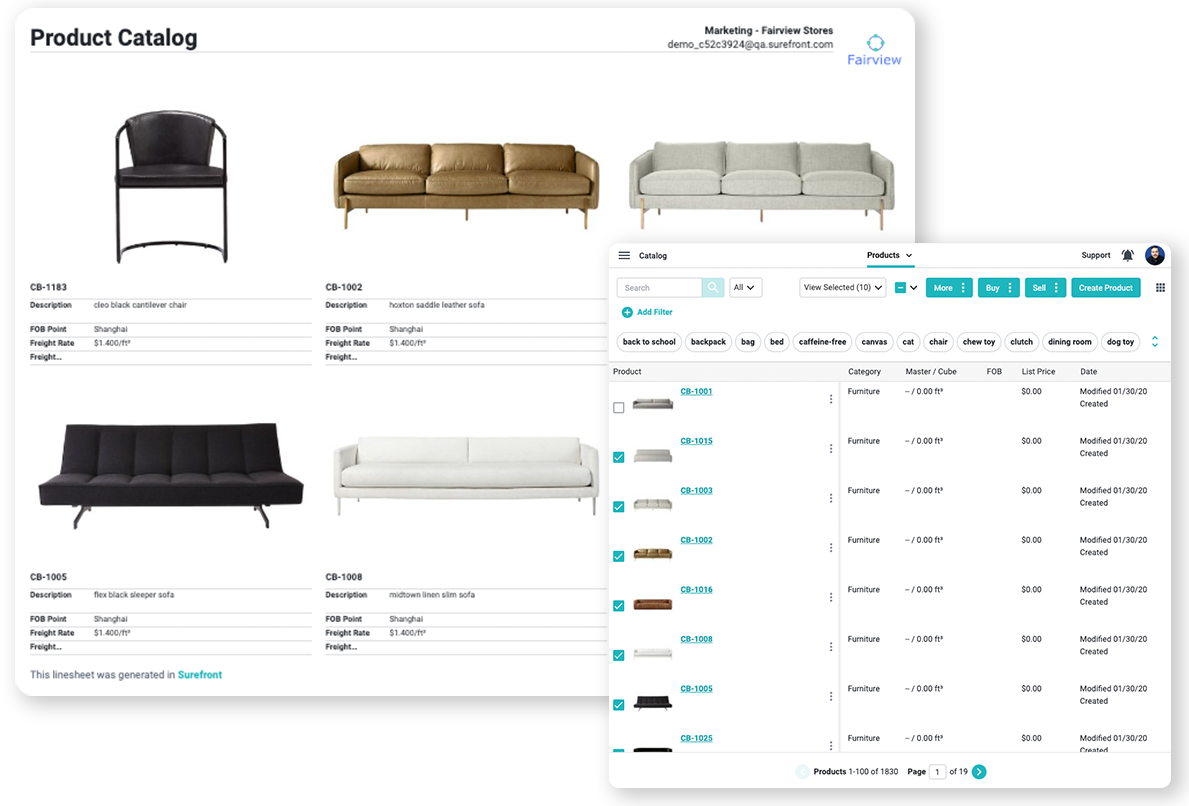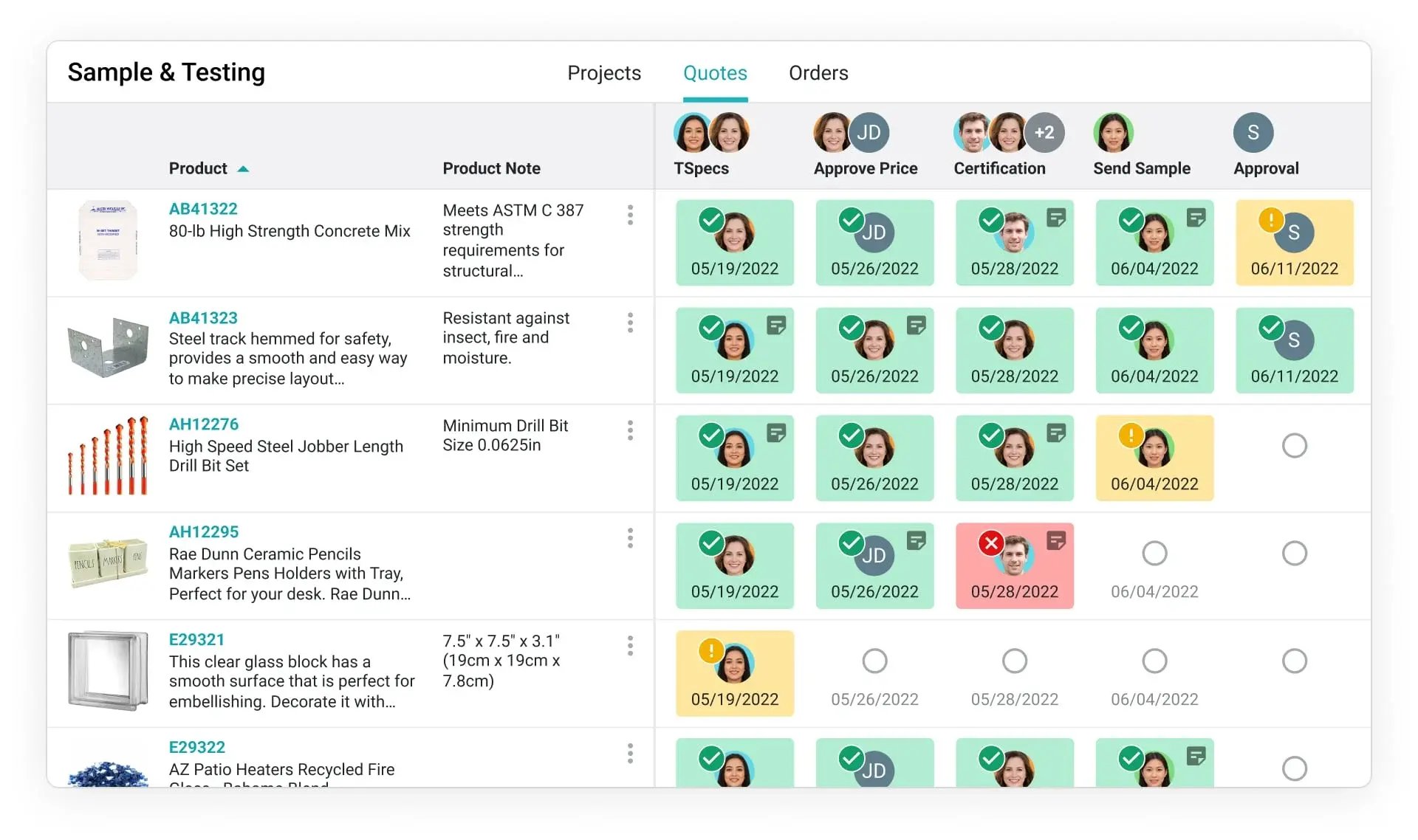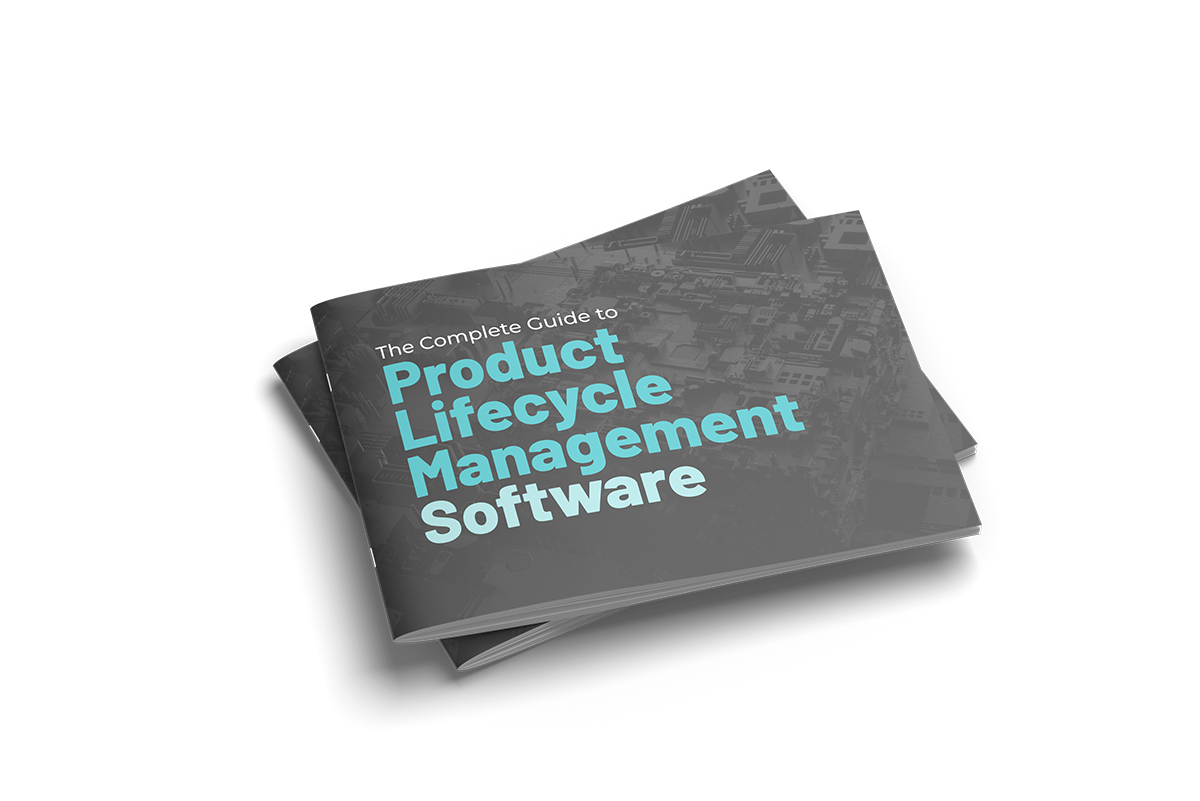Centralized Catalog Management
Manage product data instantly
Seamlessly manage and search your product catalog.
Master your product data
Centralize and simplify catalog management
- Consolidate data into a single, easy-to-access repository
- Manage attributes with flexible User Defined Fields (UDFs) using Product Data Management (PDM)
- Ensure visibility and accuracy across your product line

Streamline your operations
Solve key customer challenges within the catalog
- Find and select products to update across your catalog
- Use bulk editing tools to save time on product updates
- Generate custom line sheets and quote sheets in seconds

Enhance collaboration + comms
Utilize advanced features for team efficiency
- Track changes with event logs to view a history of updates
- Communicate seamlessly with in-platform chat
- Attach and annotate digital assets, such as images + videos through our Digital Asset Management (DAM)

Improve searchability + accessibility
Find, filter and sort information with ease
- Advanced search tools quickly locate product attributes
- Apply filters and tags to organize and categorize products
- Sort product data by attributes, ensuring quick access to critical information

Optimize your workflows + tasks
Leverage our task management tools for teams

FAQs
Retail catalog creation and management software fulfills a surprising number of functions. It is designed to streamline the process of creating, organizing, and maintaining product catalogs for retail teams.
Catalog management software for retailers provides a centralized platform for managing catalogs, creating interactive catalogs, and enriching product data –– ensuring accuracy, consistency, and accessibility across channels.
Here are some key functionalities of retail catalog creation and management software:
-
Product data organization
Catalog and product information management software allow retailers to organize product data in a sustainable manner. It provides a centralized home for product information. Whether it's titles, descriptions, attributes, images, pricing, or inventory details, it can all be stored and managed in your cloud based solution.
-
Product data enrichment
Your software will facilitate the enrichment of product data by letting you add additional information customized to each publishing platform, like product features, specifications, dimensions, and related items.
Catalog management software also supports the inclusion of rich media, including digital assets, as well as images and videos, to enhance the product content across different markets.
-
Standardization and consistency
Your catalog machine will help ensure consistency and standardization of product data across various sales channels. It lets you define and enforce both data standards and data modeling. It also keeps your data up to date while standardizing naming conventions, formats, and categorizations.
-
Bulk editing and updating
Use catalog management software to make bulk edits and updates to product data. Instead of manually modifying individual product listings, the software allows for efficient mass updates. Why waste time and effort when you don't have to?
-
Channel-specific adaptation
Retailers sell products through multiple channels: e-commerce stores, marketplaces, social media, physical stores, and third party sellers. Catalog management software adapts digital assets to fit these varied requirements. It can generate channel-specific feeds, or adapt data formats to meet your team's specific needs.
-
Multi-language and internationalization support
This one is for retailers operating in international markets, including multilingual audiences. Catalog software can provide customers with support to manage product data in multiple languages. It facilitates international sales by automating the language customization process.
-
Integration with e-commerce stores and systems
Catalog management solutions are cloud based platforms that integrate with online marketplaces, content systems, inventory systems, and other retail solutions. This integration makes your daily workflow drama-free by enabling seamless data synchronization, product comparison, and updates.
-
Workflow and collaboration
The software often includes workflow management features that facilitate collaboration among all of the disparate team members involved in catalog management. It allows you to assign tasks, track progress, and manage approvals, ensuring smooth and efficient catalog operations.
-
Reporting and analytics
Catalog management software might have reporting and analytics capabilities. Retailers can track metrics like product views, conversions, and sales. This data helps identify popular products, optimize catalogs, facilitate web data asset management, and make data-driven decisions.
-
Data validation and quality control
Catalog software helps ensure data accuracy and quality by providing validation checks and offering data cleansing capabilities. It can identify missing or inconsistent information, enforce data integrity rules, and flag potential errors for correction.
Catalog management software plays a crucial role in organizing and maintaining your retail product catalog. Here's how it helps you get it done:
-
Centralized repository
Catalog software provides a centralized data home where retailers can store and manage all product-related information. It serves as a single source of truth for product data, allowing the easy access and retrieval of information by any team member that needs it.
-
Categorization and classification
The software facilitates the organization of products into categories and subcategories. It lets you create a hierarchical structure that aligns with your specific retail offerings and business needs.
This categorization simplifies navigation for both internal team members and external stakeholders, making it easier to locate and manage products within digital catalogs.
-
Attribute management
Catalog management software allows retailers to define and manage product attributes. "Attributes," in this sense of the word, refer to details that provide specific information about a product, such as size, color, material, or weight.
The software lets retailers define attribute sets, assign attributes to products, and ensure consistency across the catalog.
-
Bulk editing and updates
Catalog software streamlines the process of making changes to product information. Instead of manually updating individual product records, the software provides bulk editing tools. Retailers can save time and effort by making updates to multiple products across multiple locations, simultaneously.
This feature is particularly valuable when handling price updates, attribute modifications, or other changes that impact multiple products.
-
Data enrichment
Catalog management software supports data enrichment by allowing retailers to add additional information to product records. This can include detailed descriptions, specifications, images, videos, customer reviews, and more.
Enriching product data enhances the overall quality and depth of information available to customers, thus increasing engagement and encouraging favorable purchase decisions.
-
Data validation and cleansing
The software includes validation checks to ensure data accuracy and integrity. It helps identify missing or inconsistent information, such as incomplete product titles or improperly formatted attributes.
By highlighting and correcting these errors, catalog software maintains data quality and consistency within the catalog.
-
Version control and history tracking
Catalog management software often includes version control features that allow retailers to track changes made to product data over time. It keeps a history of modifications, so retailers can revert to previous versions if needed. This feature helps maintain data integrity and provides a clear audit trail of catalog updates.
-
Integration with other systems
Catalog management software integrates with other retail systems, such as e-commerce platforms, content management systems, or inventory management systems. This integration ensures that product information remains synchronized across various systems, eliminating the need for manual data entry or updates.
By leveraging catalog and software solutions, you can efficiently organize and maintain product by creating digital catalogs. This ensures data accuracy, improves automated workflows and expedites the process of creating digital catalogs. Thus providing a streamlined process for managing updates and enriching product information.
These benefits contribute to an enhanced customer experience, improved operational efficiency, and increased sales opportunities –– using a fraction of the billable hours that you would with manual processes.
Yes, the best catalog management software, usually a full cloud based platform solution, is designed to handle massive digital catalogs containing from thousands to tens of thousands of SKUs (Stock Keeping Units). It should accommodate scalability and help retail teams manage the performance requirements of their various online stores, catalogs and product inventory.
Let's take a deeper look at how catalog management software handles large digital catalogs:
-
Database architecture
Catalog management software utilizes massive database architectures that can efficiently store and retrieve large volumes of data. It employs optimized data structures and indexing techniques to ensure fast and reliable access to product information.
-
Search and filtering capabilities
The software provides powerful search and filtering capabilities, allowing users to quickly locate specific products within the catalog. This enables efficient navigation and retrieval of information, even in enterprise edition catalogs with numerous products.
-
Bulk operations
Catalog management software offers bulk editing and updating functionalities to streamline operations for large or enterprise edition catalogs. Retailers can perform mass updates to product records, such as price changes or attribute modifications, saving time and effort compared to making individual updates.
-
Performance optimization
To handle the performance demands of large catalogs, the software incorporates performance optimization techniques. This may include caching mechanisms, data caching, and query optimization to ensure quick response times when accessing and modifying product data.
-
Incremental updates
Instead of processing the entire catalog with every update, catalog management software employs incremental updates. It only updates the specific changes made to products and price lists to reduce your processing time.
-
Scalable infrastructure
Catalog management software is built to scale with the growing needs of retailers. It handles increasing product volumes and adapts to accommodate expanding catalogs, without sacrificing performance. The software may support distributed computing, or a cloud-based infrastructure, to ensure scalability and handle high data volumes.
-
Data compression and storage efficiency
To optimize storage requirements, catalog management software often employs data compression techniques. By compressing product data, it reduces storage space while maintaining data integrity and accessibility.
-
System integration
Catalog management software can integrate with other retail systems, such as e-commerce platforms, catalog templates, inventory platforms, or content management systems. This ensures that product information remains synchronized across different systems, enabling efficient management of large catalogs.
When evaluating catalog management software, it's essential to consider its scalability, search functionality, and performance capabilities. The right catalog software will be able to handle your catalog size, while providing efficient data management and retrieval functionalities to ensure smooth operations... even with thousands of SKUs.
When evaluating retail catalog management software, there are a few key features you'll want to consider. The specific features will obviously vary based on your business requirements, but here are some features to choose from:
-
Centralized product data management
The software should provide a centralized repository for managing all product data, including: titles, descriptions, attributes, images, pricing, and inventory information. This centralization ensures the easy access, consistency, and accuracy of product information.
-
Data enrichment and attribute management
Look for features that allow you to enrich product descriptions by adding additional information, such as product features, specifications, dimensions, and related items. The software should also support flexible attribute management, so you can define and customize attributes based on your product catalog.
-
Bulk editing and updating
Efficient bulk editing capabilities are important for making changes to product data in large quantities. The software should allow you to perform mass updates and modifications to product records with a drag and drop interface, saving time and effort.
-
Channel adaptation and syndication
Do you sell products to different markets? Then your catalog maker should support the adaptation of product descriptions to fit the requirements of each channel. It should enable the generation of channel-specific product feeds, or provide integrations with your e commerce platform for seamless syndication of data.
-
Digital asset management and validation
The software should offer tools for enforcing data standards, such as naming conventions, attribute formats, and categorization structures. It should also include data validation checks to ensure data accuracy and integrity, while identifying errors or inconsistencies for correction.
-
Integration capabilities
Your catalog management software should integrate with your other platforms, like your online sales platforms and content management systems. Integration capabilities will enable seamless data sharing and updates across different systems.
-
Workflow and collaboration
Look for features that facilitate collaboration among all team members involved in the product catalog management process. The software should support your marketing teams and product managers in their daily workflow. Features should include: task assignment, progress tracking, and approval capabilities to streamline catalog operations and ensure efficient teamwork.
-
Reporting and analytics
Reporting and analytics capabilities provide insights into catalog performance. They also help track key metrics, like product views, conversions, and sales. Look for software that offers customizable templates and analytics dashboards to monitor the effectiveness of your product search catalog, and aid in data-driven decision making.
-
Scalability and performance
Consider the scalability of the software to handle large catalogs with thousands of SKUs. Ensure that it can efficiently manage and process the volume of data you have.
-
User-friendly interface
An intuitive and user-friendly interface is essential for your team members. Look for software that offers a clean interface, making it easy to navigate and perform catalog management tasks.
-
Customer support and training
Consider the customer support and training options that your potential software vendor offers. There can be a steep learning curve with this type of platform. So you'll want responsive support, documentation, training resources, and onboarding assistance to help train your team.
-
Customization and flexibility
Weigh the customization and flexibility available against your specific catalog software requirements. Look for the ability to customize attributes, data fields, workflows, and catalog templates. This ensures the search functionality suits your unique catalog management needs.
Absolutely. Retail catalog management software is designed to handle a wide range of product information. Catalog management software lets you upload product images and link them to corresponding products. You can typically upload multiple images for each product, including 3D views and variations.
Catalog software might also provide image management features such as resizing, cropping, and organizing images. This ensures images are attractively displayed and synchronized across all of your digital assets.
Retail catalog management software lets you input and manage product descriptions. Enter detailed descriptions that highlight product features, benefits, and specifications. It might even offer formatting options, so you can structure text, add bullet points, or format content for better readability.
Catalog pricing management software lets you define and manage product pricing information and catalog content. You can set your base price, then create pricing rules for different scenarios, such as discounts, promotions, or tiered pricing.
The best catalog management software starts by providing the flexibility to handle complex pricing structures. This includes differentiating pricing based on your customer groups or geographical locations. It ensures that accurate pricing information is maintained across the interactive elements of your product and online catalogs, and synchronized across your digital commerce channels.
A retail catalog product information management solution might also handle other types of product data, like attributes, SKU variations, inventory data, related products, and price lists. It's a comprehensive solution that manages all the necessary information tied to your brand story and product catalog content.
It's worth noting that the specific capabilities and features may vary among different product catalog management software solutions. When evaluating options, it's important to ensure that the catalog maker software in question can handle the types of product data that are relevant to your business.
You'll also want to confirm that it provides the necessary flexibility and customization options to help you get your product to consumer faster.
The best catalog management software can integrate with various sales platforms. This integration allows for the automatic transfer of product information from your catalog management software to the e-commerce platform in question.
Seamless integration ensures that your product information –– including product name, descriptions, images, pricing, and inventory levels –– remain consistent and up to date across all of your systems. It eliminates the need for manual product data entry and minimizes the risk of errors or discrepancies across your channels.
Yes, catalog management software supports multi-channel selling and the syndication of information on product attributes to differentiated channels. Catalog management software integrates with a wide range of sales channels, including: online retailers, marketplaces, social media platforms, and more.
It provides integrations with these channels, enabling retailers to connect their online catalogs and management software to the desired sales channels. Catalog management software also allows retailers to generate channel-specific product feeds.
These feeds contain the necessary product information, such as titles, descriptions, images, pricing, and custom product attributes –– formatted in a way that is compatible with the requirements of each channel. The software can even generate feeds in various formats, such as CSV, XML, or API feeds, depending on the channel's specifications.
Catalog management software ensures that your product data is properly aligned with the requirements of each sales channel. It allows you to map product attributes from your catalog to the corresponding requirements of each sales channel, automatically.
Retailers and ecommerce businesses can use catalog management software to automate the syndication of product data to all of their different sales channels. Instead of manually entering or updating product information on each channel, the software automates the process by sharing the updated data to all respective channels.
This saves time, reduces errors, and ensures that the product information is consistently updated across all channels.
Catalog management software integrates with other inventory management systems and pricing systems to provide real-time updates to sales channels. When a product is sold or your inventory level changes, the software will update the information across all connected channels to reflect its current availability.
Price changes or promotions can also be automatically synchronized across channels, ensuring consistent pricing information.
Catalog product feed management software provides a centralized control panel or dashboard where you can manage your multi-channel selling activities. You can review channel performance, refine your product offerings, track sales, monitor inventory levels, and make updates to product information from a single interface.
A centralized catalog with built-in product information management software simplifies the process of managing multiple sales channels, ensuring control over your product data.
By leveraging catalog management software's multi-channel selling capabilities, you can expand your reach and presence. It enables efficient syndication of product data, ensures consistency in product information across multiple sales channels, and simplifies the management of multi-channel operations.
This will help you reach a broader customer base, increase sales opportunities, and enhance the overall visibility and competitiveness of your retail business.
Using catalog management software offers several benefits for retail businesses.
Catalog management software automates and streamlines manual tasks involved in managing product catalogs. It reduces the time and effort required for data entry, updates, and organization. With centralized product data entry management and bulk editing capabilities, you can efficiently make changes to manage product catalogs and information.
Catalog management software ensures consistency and accuracy in product information across various channels. By enforcing data standards and validation checks, it minimizes errors and inconsistencies in product titles, descriptions, attributes, and pricing. This consistency enhances the customer experience and builds trust.
Manual catalog creation and digital asset management processes can be time-consuming and resource-intensive. By automating tasks such as data entry and updates, catalog management software saves time and reduces the need for manual labor. This translates into cost savings and allows your team to focus on higher-value activities.
With catalog and product information management solutions, you can adapt and syndicate your entire catalog and product data to various channels, online stores, retailers and online marketplaces.
It facilitates the generation of channel-specific product feeds and ensures that your product information is accurately represented across different platforms. This expands your reach and allows you to target a wider customer base.
Catalog management software enables you to enrich your product data by adding additional information, such as detailed descriptions, images, specifications, etc. Enriched product data provides a more comprehensive and engaging shopping experience for your customers, increasing your chances of conversions and sales.
With streamlined processes and efficient data management, catalog management software helps you bring new products to market faster. Use it to quickly create and publish product listings, reducing the time it takes to launch new products and respond to market demands.
Accurate and detailed product information, enriched web content management, and consistent branding are just part of the value proposition. Catalog and web content management software helps you deliver relevant and engaging product information for more informed purchasing decisions and improved customer satisfaction.
Catalog management software solutions often offer reporting and analytics capabilities. This lets you track key metrics, like product views, conversions, and sales performance. These insights help you home in on trends, suss out your catalog's effectiveness, and make data-driven decisions that optimize your offerings and marketing workflows.
The right product catalog management software will scale with your business as your product catalog grows. It will handle massive volumes of product data, and ensure smooth operations... even with thousands of SKUs. In short, the right catalog management software will facilitate your growth trajectory, allowing you to manage an ever-increasing product range with ease.
Using software to streamline and manage product catalogs can help both ecommerce stores and physical retail businesses to improve data accuracy and consistency, enhance the customer experience, and achieve operational efficiency. This will help you achieve increased sales, customer satisfaction, and unparalleled business growth.
Case Studies

Fine Jewelry
West coast fine jeweler shaves weeks off production time, days off line sheet development, and hours off vendor communication and SKU management.

Home Décor
Surefront enables industry-leading productivity and unparalleled sales. Tasks that formerly took JIA HOME two weeks now take just 30 minutes.

Home Furnishings
Surefront’s PLM helped the Handy Living team reduce the average new product development cycle from 6-12 months time to 3 months per product.
From Our Blog

The Complete Guide to Catalog Management

Evolve Your Product Catalog into a Powerful Tool for Growth

Boost Your Catalog Management with Key Metrics
Download the Complete Guide to Produce Lifecycle Management
Get Your Free Copy Today!


